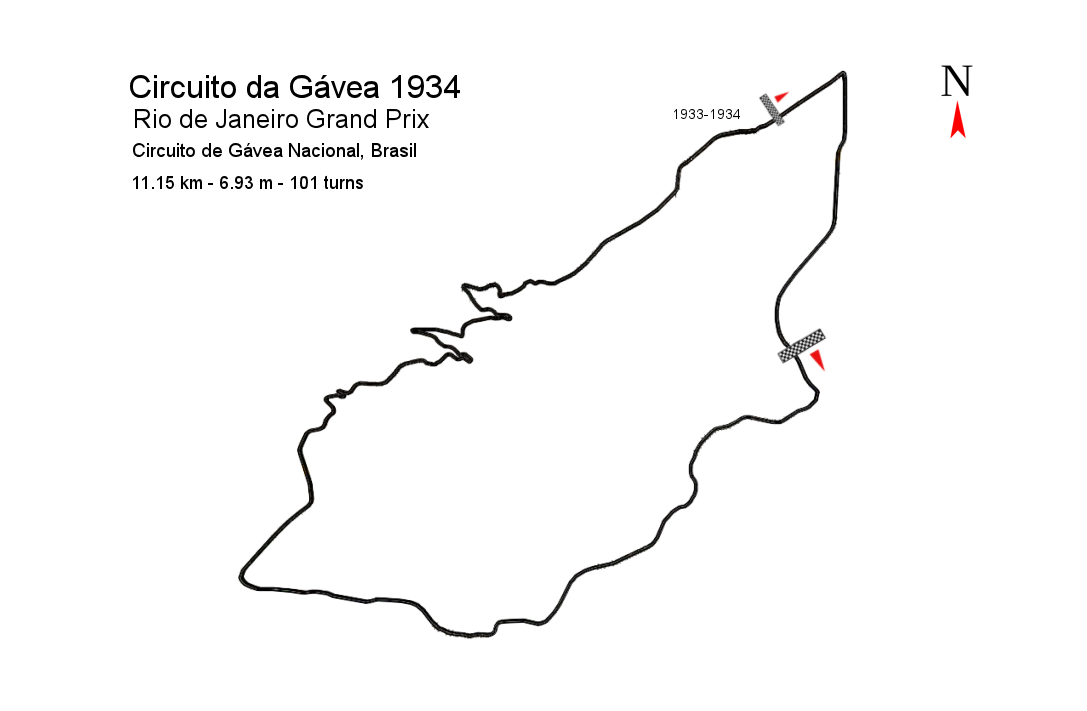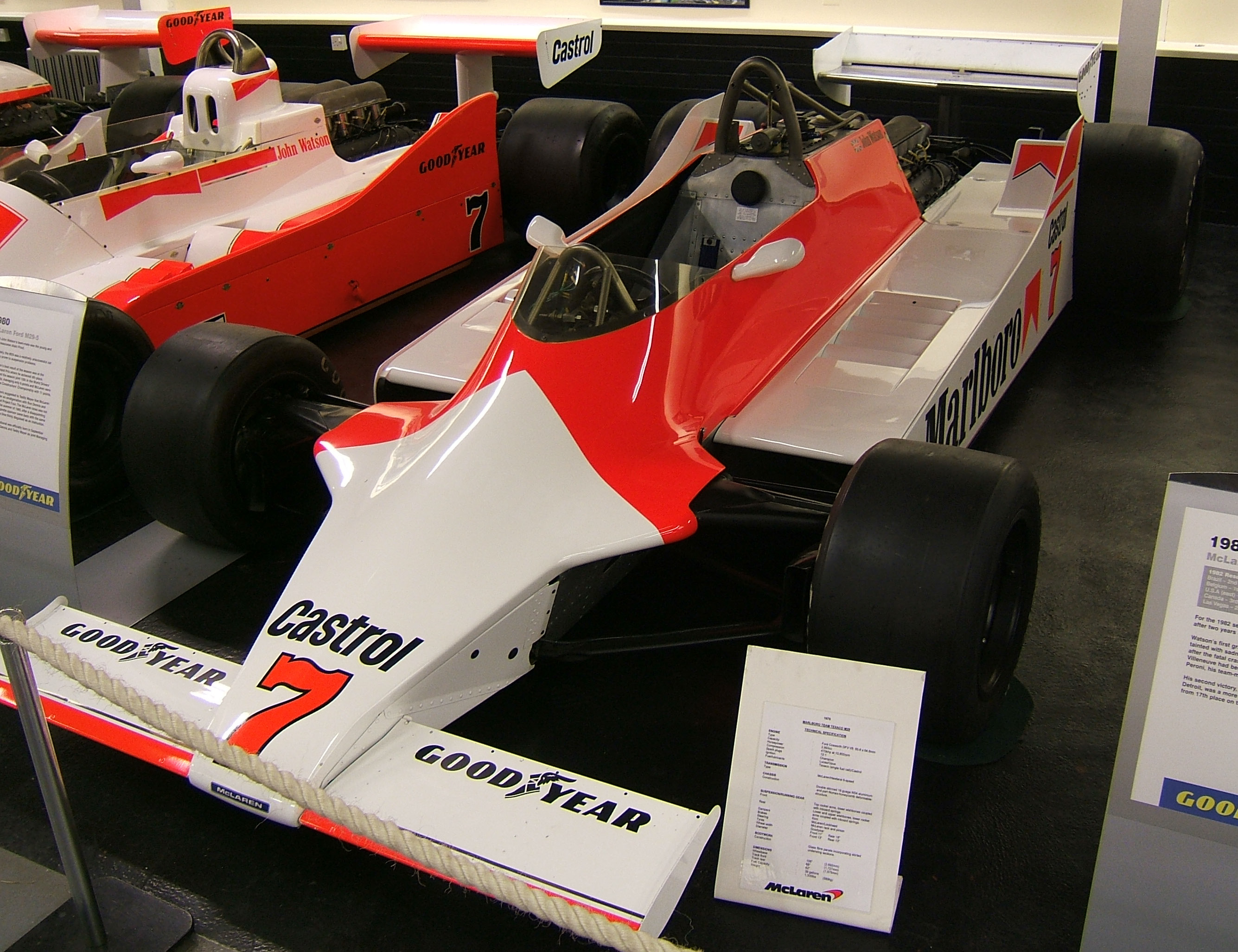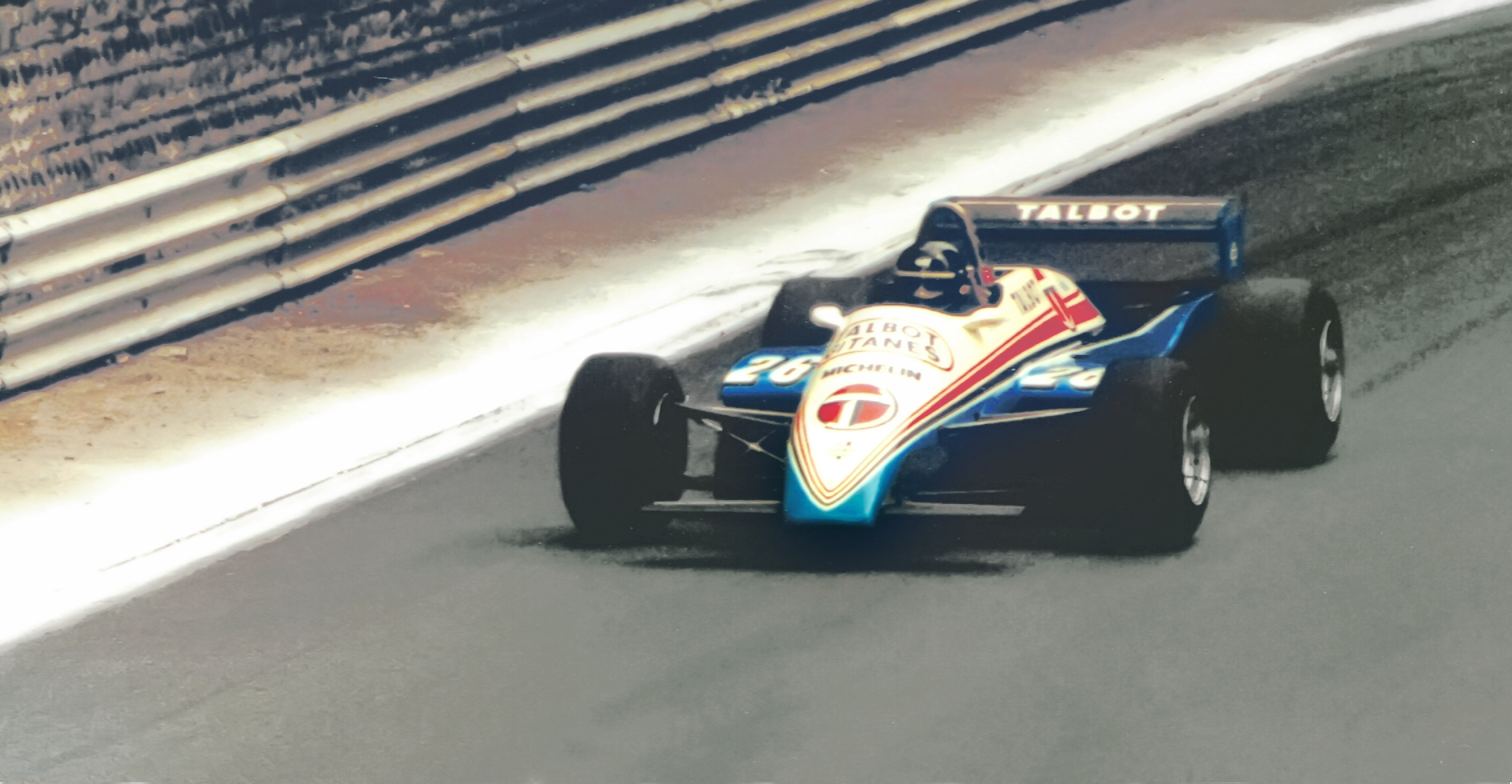|
1980 Brazilian Grand Prix
The 1980 Brazilian Grand Prix was a Formula One motor race held on 27 January 1980 at the Interlagos circuit in the Interlagos neighborhood of São Paulo. It was the second round of the 1980 Formula One season, and it was also the ninth Brazilian Grand Prix. It was the eighth to be held at Interlagos and would be the last until the circuit was substantially redeveloped for the 1990 Brazilian Grand Prix. The race was held over 40 laps of the 7.87-kilometre (4.9 mile) circuit for a total race distance of 315 kilometres. This race was originally supposed to be held at the Jacarepaguá circuit in Rio de Janeiro, but was transferred to Interlagos because parts of the Rio circuit's tarmac were actually sinking into the soft swampland the circuit was built on. This last-minute switch to Interlagos- which was to be resurfaced and heavily rebuilt with new pit facilities and safety measures for the 1981 season caused much controversy- Interlagos had returned a bit too soon for some of the driv ... [...More Info...] [...Related Items...] OR: [Wikipedia] [Google] [Baidu] |
Brazilian Grand Prix
The Brazilian Grand Prix (), currently held under the name São Paulo Grand Prix (), is a Formula One championship race which is currently held at the Autódromo José Carlos Pace in Interlagos neighborhood, Cidade Dutra, São Paulo. The inaugural Brazilian Grand Prix, held in , was held as a non-championship event, with all races from the Brazilian Grand Prix onwards held as a championship event. Previously, the race was held at Jacarepaguá from to , before returning to Interlagos in , where it has since been held. Origins Motor racing started in Brazil before World War II, with races on the Gávea street circuit in Rio de Janeiro starting in 1934. In 1936 construction began on Brazil's first permanent autodrome in the São Paulo neighborhood of Interlagos and was finished in 1940. Brazil held Grands Prix during the early parts of WWII at Interlagos and Gavea. Interlagos, a circuit inspired in layout by the Roosevelt Raceway in the United States quickly gained a ... [...More Info...] [...Related Items...] OR: [Wikipedia] [Google] [Baidu] |
Rio De Janeiro
Rio de Janeiro, or simply Rio, is the capital of the Rio de Janeiro (state), state of Rio de Janeiro. It is the List of cities in Brazil by population, second-most-populous city in Brazil (after São Paulo) and the Largest cities in the Americas, sixth-most-populous city in the Americas. Founded in 1565 by the Portuguese people, Portuguese, the city was initially the seat of the Captaincy of Rio de Janeiro, a domain of the Portuguese Empire. In 1763, it became the capital of the State of Brazil, a List of states of the Portuguese Empire, state of the Portuguese Empire. In 1808, when the Transfer of the Portuguese Court to Brazil, Portuguese Royal Court moved to Brazil, Rio de Janeiro became the seat of the court of Queen Maria I of Portugal. She subsequently, under the leadership of her son the prince regent John VI of Portugal, raised Brazil to the dignity of a kingdom, within the United Kingdom of Portugal, Brazil and the Algarves, United Kingdom of Portugal, Brazil, and Algar ... [...More Info...] [...Related Items...] OR: [Wikipedia] [Google] [Baidu] |
Arrows A3
The Arrows A3 was a Formula One car which the Arrows team used to compete in the 1980 and 1981 Formula One seasons. After the failure of the A2 in the 1979 Formula One season, the A3 was a very conventional design. The A3 featured a short wheelbase and conventional front nose and rear wing. The only aerodynamic novelty was a gearbox enclosure to reduce drag. The car was used in 1981, as Arrows did not have the resources to create a car with hydropneumatic suspension Hydropneumatic suspension is a type of motor vehicle suspension system, invented by Paul Magès, produced by Citroën, and fitted to Citroën cars, as well as being used under licence by other car manufacturers. Similar systems are also widely u ... like the Brabham BT49C. Complete Formula One World Championship results ( key) (results in bold indicate pole position) References A03 {{F1-stub ... [...More Info...] [...Related Items...] OR: [Wikipedia] [Google] [Baidu] |
Riccardo Patrese
Riccardo Gabriele Patrese (born 17 April 1954) is an Italian former racing driver, who competed in Formula One from to . Patrese was runner-up in the Formula One World Drivers' Championship in with Williams, and won six Grands Prix across 17 seasons. He became the first Formula One driver to achieve 200 Grand Prix starts when he appeared at the 1990 British Grand Prix, and then became the first to achieve 250 starts at the 1993 German Grand Prix. For 19 years, he held the record for the most Formula One Grand Prix starts, with 256 races from 257 entries. As of the end of the season he is the tenth-most experienced F1 driver in history. At the age of 38 he was runner-up to Nigel Mansell in the 1992 Formula One World Championship, and third in and . He won six Grands Prix, including the 1982 Monaco Grand Prix, with a record gap of over six years between two of these – the 1983 South African Grand Prix and 1990 San Marino Grand Prix. Patrese also competed at the Wor ... [...More Info...] [...Related Items...] OR: [Wikipedia] [Google] [Baidu] |
McLaren M29
The McLaren M29 is a Formula One racing car built and run by McLaren during the 1979 Formula One World Championship and the 1980 Formula One World Championship. The F version of the McLaren M29 was built in 1979, but only ran during five races of the 1981 Formula One World Championship. The M29F was the last of the M-numbered cars to be raced, as later in the season, the McLaren MP4/1 was readied for use in the championship. Specifications Complete Formula One World Championship results ( key) (results in bold indicate pole position) (results in ''italics'' indicate fastest lap) * 8 points in scored using the McLaren M28 ** 1 point in scored using the McLaren M30 *** 27 points in scored using the McLaren MP4/1 The McLaren MP4/1 (initially known as the MP4) was a Formula One racing car produced by the McLaren team. It debuted at round three of the 1981 season, the , and saw continued use in 1982 and 1983. It was one of the first Formula One cars to us ... Refe ... [...More Info...] [...Related Items...] OR: [Wikipedia] [Google] [Baidu] |
Alain Prost
Alain Marie Pascal Prost (; born 24 February 1955) is a French former racing driver and motorsport executive, who competed in Formula One from to . Nicknamed "the Professor", Prost won four Formula One World Drivers' Championship titles and—at the time of his retirement—held the List of Formula One driver records, records for most List of Formula One Grand Prix winners, wins (51), List of Formula One drivers who set a fastest lap, fastest laps (41), and List of Formula One driver records#Total podium finishes, podium finishes (106). Born in Lorette, Loire, Prost began karting aged 14, winning the KF3, junior direct-drive Karting World Cup four years later, and progressing to junior formulae in 1976. Prost won his first title at the Formula Renault 2.0 West European Cup, Formula Renault National Championship that year, prior to winning the Formula Renault#Championships, Challenge de Formule Renault Europe in 1977. Replaced by the French Formula Three Championship the follow ... [...More Info...] [...Related Items...] OR: [Wikipedia] [Google] [Baidu] |
Didier Pironi
Didier Joseph Louis Pironi (26 March 1952 – 23 August 1987) was a French racing driver and offshore powerboat racing, offshore powerboat racer, who competed in Formula One from to . Pironi was runner-up in the Formula One World Drivers' Championship in with Scuderia Ferrari, Ferrari, and won three List of Formula One Grands Prix, Grands Prix across five seasons. In endurance racing (motorsport), endurance racing, Pironi won the 24 Hours of Le Mans in with Renault Sport, Renault. Born and raised in Val-de-Marne, Pironi was the half-brother of racing driver José Dolhem. After initially studying engineering, he enrolled at the Winfield Racing School at Paul Ricard Circuit, Paul Ricard, earning a scholarship to compete in Formula Renault, where he won the Formula Renault Eurocup, Eurocup in List of Formula Renault 2.0 champions, 1974 and List of Formula Renault 2.0 champions, 1976. After finishing third in the 1977 European Formula Two Championship, Pironi progressed to Formul ... [...More Info...] [...Related Items...] OR: [Wikipedia] [Google] [Baidu] |
Jacques Laffite
Jacques-Henri Laffite (; born 21 November 1943) is a French former racing driver and broadcaster, who competed in Formula One from to . Laffite won six Formula One Grands Prix across 13 seasons. Born and raised in Paris, Laffite trained as a racing driver with the Winfield Racing School at Magny-Cours in 1968. Laffite twice entered the 24 Hours of Le Mans with Ligier before making his Formula One debut at the 1974 German Grand Prix with Frank Williams. Laffite remained at Frank Williams through the season, scoring his maiden podium at the and winning the European Formula Two Championship with Martini. He moved to Ligier in , taking several podiums amongst his maiden pole position in Italy. Laffite retained his seat the following season, taking his maiden win at the . After a winless season in , Ligier constructed the highly-competitive JS11 in response to the ground effect era. Laffite won the opening two rounds of the season—including a grand slam at the —bu ... [...More Info...] [...Related Items...] OR: [Wikipedia] [Google] [Baidu] |
Ferrari 312T5
The Ferrari 312T was a Ferrari Formula One car design, based on the 312B3 from 1974. In various versions, it was used from 1975 until 1980. It was designed by Mauro Forghieri for the 1975 season, and was an uncomplicated and clean design that responded well to mechanical upgrades. The 312T series won 27 races, four Constructors' and three Drivers' Championships, making it the most successful car design in Formula One history. It was replaced for the 1981 season by the 126 C, Ferrari's first turbocharged F1 car. It was also Ferrari's last naturally-aspirated F1 car until the Ferrari 640 in 1989, after the ban on turbocharged engines. Mechanical configuration The car was powered by the powerful and reliable ''Tipo'' 015 flat-12 engine which gave around 510 bhp. Although it had to carry more fuel, oil and water than the Cosworth DFV-powered cars the power-to-weight ratio of the flat-12 was about the same as the DFV. The "3" stood for the car's engine displacement (3 l ... [...More Info...] [...Related Items...] OR: [Wikipedia] [Google] [Baidu] |
Gilles Villeneuve
Joseph Gilles Henri Villeneuve (; 18 January 1950 – 8 May 1982) was a Canadian racing driver, who competed in Formula One from to . Villeneuve was runner-up in the Formula One World Drivers' Championship in with Ferrari, and won six Grands Prix across six seasons. A racing enthusiast from an early age, Villeneuve started his career in snowmobile racing across his native province of Quebec. He soon progressed to open-wheel racing, winning the regional Formula Ford championship in 1973 before graduating to Formula Atlantic, where he won two Canadian Championships in 1976 and 1977, and the American Championship in 1976. Villeneuve made his Formula One debut with McLaren at the 1977 British Grand Prix, impressing Enzo Ferrari, who signed him with Ferrari for . He made an early debut for the team at the after the departure of World Champion Niki Lauda, and was involved in a collision with Ronnie Peterson which killed two bystanders at the season-ending . Amidst struggles with ... [...More Info...] [...Related Items...] OR: [Wikipedia] [Google] [Baidu] |
Ligier JS11/15
The Ligier JS11 was a ground effect Formula One car designed by Gérard Ducarouge. It was powered by the Ford Cosworth DFV married to a Ligier in-house built gearbox. It competed in the and World Championships and proved to be very competitive. Driven by Jacques Laffite, the car won the first two races of the 1979 season and scored consistently.''The Observer'' page 32 Sunday 4 February 1979 The Ligiers stayed in contention throughout the season, with Patrick Depailler winning a further race in Spain. The team eventually finished third behind Ferrari and Williams in the constructors' championship. Depailler was injured halfway through the season in a hang-gliding accident and was replaced by Jacky Ickx, but he struggled to keep pace with the car and his teammate and left at the end of the season, having scored only a handful of points. However, the car soon proved to have problems, starting at the fourth race of the season at Long Beach in the United States. The car was in fa ... [...More Info...] [...Related Items...] OR: [Wikipedia] [Google] [Baidu] |
Williams FW07B
The Williams FW07 was a ground effect Formula One racing car designed by Patrick Head, Frank Dernie, and Neil Oatley for the 1979 Formula One season. Developed versions of the car were used in the , and seasons. Design 1979 It was closely based on the Lotus 79, even being developed in the same wind tunnel at Imperial College London. Some observers, among them Lotus aerodynamicist Peter Wright felt the FW07 was little more than a re-engineered Lotus 79, just having a stiffer chassis. The car was small and simple and extremely light, powered by the ubiquitous Ford Cosworth DFV. It had very clean lines and seemed to be a strong challenger for the new season, but early reliability problems halted any serious threat for the title. While not the first to use ground effects in Formula One, an honour belonging to Colin Chapman and the Lotus 78 (the Lotus 79's predecessor), Dernie may have had a better grasp of the principles than even Chapman. While Head had been developing the ... [...More Info...] [...Related Items...] OR: [Wikipedia] [Google] [Baidu] |








